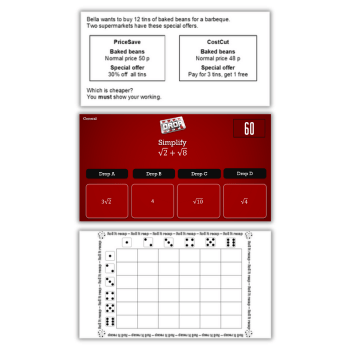Maths teaching – Addressing educational inequality

Tom Francome explains how a new, evidence-informed curriculum is seeking to reimagine how maths is taught at KS3

- by Tom Francome

The Loughborough University Mathematics Education Network (LUMEN) recently launched a free, evidence-informed and fully resourced maths teaching curriculum for KS3.
Here, I’d like to set out some of the principles and challenges involved in this, and why we believe it’s an important step towards increasing equity for young people.
Better performance at school will improve pupils’ life chances. But what do we actually know about how we can improve educational outcomes? Education policy often tends to focus on improving the quality of teaching. However, teaching quality is notoriously difficult to measure, never mind influence.
However, one frequently overlooked area is the quality of the curriculum we teach learners. It seems obvious that curriculum considerations should be at the heart of educational practice. However, in the interests of maintaining perceived professional autonomy, we typically leave the ‘what’ and ‘how’ of teaching underspecified.
Instructional design
Research has shown that the use of higher-quality curriculum materials over lower-quality materials can have a significant impact on pupil outcomes.
Higher quality materials improve student learning via the reduced levels of time, expense and workload they require on the part of teachers.
Narrowing the attainment gap is a complex problem that we can’t solve easily. However, greater specificity about content does tend to enhance equity, as shown by the work of Steiner et al.
Furthermore, teachers will typically follow the order of curriculum materials. The instructional design of said materials often influences those teachers’ pedagogical approaches.
In the UK, we have a National Curriculum that specifies what to teach, but not how to teach it. Teachers are left to figure out the latter for themselves.
Broadly speaking, schools have two ways in which to proceed. They can curate the resources available to them in the online curriculum bazaar, or buy into a published scheme.
Resourcing over planning
The first option seems as though it would support teachers’ autonomy while providing a tailored experience for learners. However, it vastly underestimates the complexities involved in maths teaching.
Designing high-quality resources is difficult, and demands a very different form of expertise to classroom teaching.
We don’t expect great doctors to invent the medicines they use, nor great actors to write the scripts they perform.
What teachers need is the best available resources to teach the content – which they’re unlikely to be even able to source, given their limited planning time (less than seven minutes per lesson, if using only their allotted PPA time), let alone use effectively after careful planning.
With the bulk of their preparation time taken up with sourcing materials, teachers thus end up resourcing their lessons, rather than planning them.
This can often lead to feelings of guilt, or a sense that there’s something better out there, if only they had more time to look.
What’s worse is that even if teachers do have access to the best available materials, the job of actually sequencing them into a meaningful story for learners is no mean feat. This is because the best individual resources may use different, or even conflicting models and representations.
This further limits the overall coherence – in the same way that we couldn’t expect a writer to make a coherent story by piecing together their favourite scenes from different genres.
Quick and costly decisions
You could be forgiven for seeing the option of using a published scheme as a superior alternative. However, published schemes can have inherent design issues of their own.
Trending
Teachers will naturally expect published resources to be thoroughly thought through. However, they differ vastly in terms of quality and coherence.
We often force busy subject leaders into making quick and costly decisions based on just a brief look at the materials in question, with the (understandable) expectation that they’ll be of high quality.
Later on, teachers discover that these schemes have superficial coherence at best, and aren’t informed by mathematics education, cognitive science, and/or educational design.
In a 2014 policy paper titled ‘Why Textbooks Count’, Tim Oates wrote of a ‘chronic market failure’. This is where high-stakes accountability compels teachers to demand exam-centric materials, prompting publishers to meet said demand.
The upshot is that the exam specification becomes the de facto KS4 curriculum. Meanwhile, we neglect the developmentally important KS3 curriculum.
A principled approach
It’s these issues that the LUMEN curriculum aims to address. Drawing on the expertise of Loughborough’s Department for Mathematics Education, we intend it to be a free, evidence-informed and coherent mathematics curriculum.
It presents a viable alternative to both expensive, often low-quality commercial materials and the time-consuming task of resource curation.
The LUMEN curriculum integrates international research findings within its very design. It remains actively iterated upon via real classroom trials to ensure continual improvement.
We place a particular emphasis on coherence. The curriculum seeks to unify topics through consistent representations and contexts, drawing on Leslie Dietiker’s notion of the curriculum as a coherent story.
Recognising the pivotal role performed by skilled teachers, LUMEN also stresses the importance of effective collaboration between school leaders and teachers. It acknowledges the need to support professional decision-making with suitable guidance.
Cognitive science is able to provide useful insights into effective learning strategies that can often be overlooked in traditional approaches. We have seen increasingly frequent calls for school mathematics curricula to be informed by robust research evidence, yet teachers often report finding insights from cognitive science difficult to implement.
Consistent representations
In designing the LUMEN curriculum, we have examined several of the challenges in applying principles from cognitive science to the design of a school mathematics curriculum and tried to balance them (Foster et al., 2024). For example, we have prioritised the use of consistent representations – such as the number line – even where doing so might make things more challenging in the short-term, so that benefits can be reaped in the long-term.
The LUMEN curriculum will hopefully be useful for new and more experienced colleagues alike. It offers a free, editable starting point that teachers can then adapt to the needs of their learners, and could prompt some broader discussions around pedagogy.
We additionally hope that its materials will offer a more compelling story for teachers to begin with, compared to a blank page, and provide helpful detail on both what to teach and how to teach it. We’ve seen how inequalities persist in mathematics education, with students from disadvantaged backgrounds and under-represented groups regularly facing significant challenges.
Access to high-quality maths teaching materials informed by cognitive science could help to bridge some of those gaps, and offer a more equitable learning experience – regardless of socioeconomic status, gender or race.
5 key principles of maths teaching
As detailed earlier this year by Colin Foster et al. in BERA’s Curriculum Journal, the development of the LUMEN curriculum observed five key design principles, which state that a mathematics curriculum should:
- Harness and develop the skills and expertise of teachers
- Balance the teaching of fluency, reasoning and problem-solving
- Give explicit attention to important errors and misconceptions
- Compare and contrast alternative methods
- Engineer coherence through strategic use of consistent representations and contexts
Tom Francome is a senior enterprise fellow at the Department of Mathematics Education, Loughborough University; further information about the LUMEN curriculum and access to its free resources can be found here







